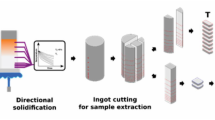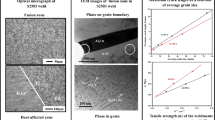Abstract
Heat-treatable Al-Zn alloys are promising candidates for use as structural lightweight materials in automotive and aircraft applications. This is mainly due to their high strength-to-density ratio in comparison to conventionally employed Al alloys. Laser beam welding is an efficient method for producing joints with high weld quality and has been established in the industry for many years. However, it is well known that aluminum alloys with a high Zn content or, more precisely, with a high (Zn + Mg + Cu) content are difficult to fusion weld due to the formation of porosity and hot cracks. The present study concerns the laser weldability of these hard-to-weld Al-Zn alloys. In order to improve weldability, it was first necessary to understand the reasons for weldability problems and to identify crucial influencing factors. Based on this knowledge, it was finally possible to develop an appropriate approach. For this purpose, vanadium was selected as additional filler material. Vanadium exhibits favorable thermophysical properties and, thereby, can improve the weldability of Al-Zn alloys. The effectiveness of the approach was verified by its application to several Al-Zn alloys with differing amounts of (Zn + Mg + Cu).


















Similar content being viewed by others
Notes
LECO is a trademark of LECO Corporation, St. Joseph, MI.
References
I.N. Fridlyander and O.G. Senatorova: Mater. Sci. Forum, 1996, vol. 217, pp. 1813–18.
K. Cudney: Welding Int., 1993, vol. 7 (8), pp. 599–603.
T. Ma: Ph.D. Thesis, Delft University of Technology, Delft, 1997.
W. Zhou: Singapore Welding Society Newsletter, Sept. 1999.
N. Kamp, A. Sullivan, and J.D. Robson (2007) Mater. Sci. Eng. A, 466:246–55.
G. Verhaeghe: Ph.D. Thesis, University of Warwick, Warwick, 2008.
S.C. Wu, X. Yu, R.Z. Zuo, W.H. Zhang, H.L. Xie and J.Z. Jiang: Welding J., 2013, vol. 92 (3), pp. 64–71.
M. Olabode, P. Kah, and A. Salminen: Rev. Adv. Mater. Sci., 2015, vol. 42 (1), pp. 6–19.
M. Olabode: Ph.D. Thesis, University of Technology, Lappeenranta, Lappeenranta, 2015.
L. Zhang, X. Li, Z. Nie, H. Huang, and J. Sun: Mater. Design, 2015, vol. 83, pp. 451–58.
S. Anik and L. Dorn: Schweißeignung Metallischer Werkstoffe, DVS, Düsseldorf, 1995.
T. Ma and G. den Ouden: Mater. Sci. Eng.: A, 1999, vol. 266 (1), pp. 198–204.
L.F. Mondolfo: Aluminium Alloys: Structure and Properties, Butterworth and Co., London, 1979, pp. 842–82.
J. Rapp, M. Beck, F. Dausinger, and H. Hügel: Proc. 5th ECLAT, Bremen, Sept. 1994, DVS-Verlag, Düsseldorf, 1994, pp. 313–25.
K.H. Leong and H.K. Geyer: Proc. ICALEO, Orlando, FL, Nov. 1998, Laser Institute of America, Orlando, FL, 1998, vol. 85 (2), pp. F-243–F-251.
K.H. Leong, H.K. Geyer, K.R. Sabo, and P.G. Sanders: Proc. ICALEO, San Diego, CA, Nov. 1997, Laser Institute of America, Orlando, FL, 1997, vol. 83 (2), pp. G-1–8.
A. Block-Bolten and T.W. Eager: Metall. Trans. B, 1984, vol. 15 (3), pp. 461–69.
H. Zhao and T. DebRoy: Welding J., 2001, vol. 80 (8), pp. 204–10.
W.M. Haynes: CRC Handbook of Chemistry and Physics, 92nd ed., CRC Press, Boca Raton, FL, 2011, pp. 6-88.
E. Beyer: Schweißen mit Laser - Grundlagen, Springer, Berlin, 1995, pp. 28–40.
W.M. Steen, J. Dowden, M. Davis, and P. Kapadia: J. Phys. D: Appl. Phys., 1988, vol. 21 (8), pp. 1255–60.
G. Guizzetti and A. Piaggi: Handbook of Optical Constants of Solids 2, 1st ed., Academic Press, New York, NY, 1998, pp. 477–85.
P.N. Anyalebechi: Scripta Metall., 1995, vol. 33 (8), pp. 1209–16.
M. Mazur: Welding Int., 1992, vol. 6 (12), pp. 929–31.
S. Riekehr, H. Iwan, R. Dinse, V. Ventzke, and P. Haack: European Patent No. EP20120162865, 2012.
J. Enz, S. Riekehr, V. Ventzke, and N. Kashaev: Mater. Sci. Forum, 2015, vols. 828–829, pp. 389–94.
Author information
Authors and Affiliations
Corresponding author
Additional information
Manuscript submitted June 16, 2015.
Rights and permissions
About this article
Cite this article
Enz, J., Riekehr, S., Ventzke, V. et al. Laser Weldability of High-Strength Al-Zn Alloys and Its Improvement by the Use of an Appropriate Filler Material. Metall Mater Trans A 47, 2830–2841 (2016). https://doi.org/10.1007/s11661-016-3446-2
Published:
Issue Date:
DOI: https://doi.org/10.1007/s11661-016-3446-2




